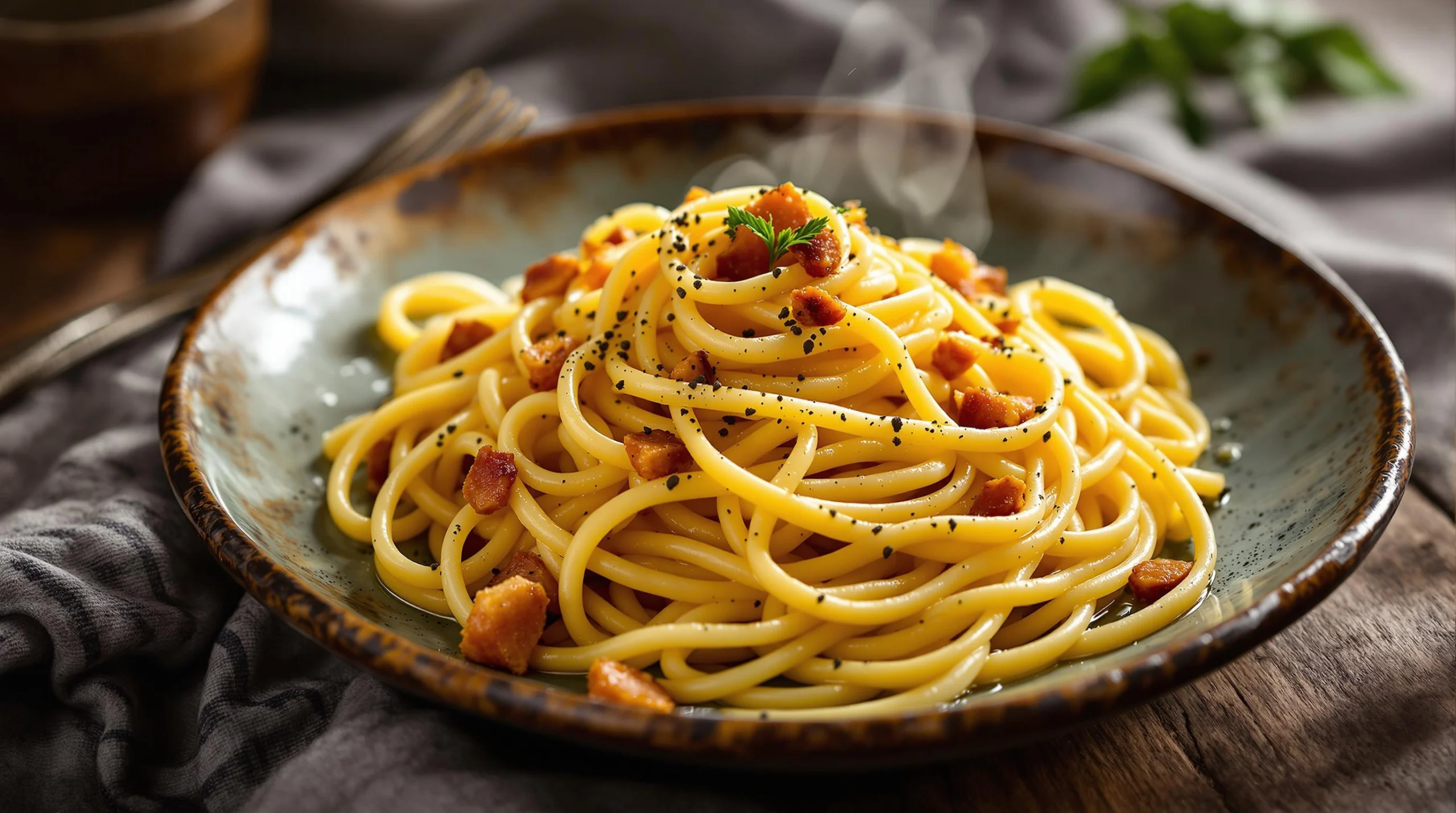There’s nothing quite like the first time I watched my Italian mentor, Chef Giovanni, prepare authentic carbonara in his tiny Roman kitchen. “No cream, Alex!” he’d scold with a smile whenever I suggested it. “Carbonara doesn’t need cream—the magic happens when hot pasta transforms eggs and cheese into silk.” That culinary lesson stayed with me through decades of professional cooking, and today I’m sharing the authentic Roman carbonara that honors tradition while being accessible to home cooks everywhere. 🇮🇹
The True Story of Carbonara 📖
Carbonara emerged in mid-20th century Rome, likely created from the eggs and bacon American soldiers brought during World War II. The name itself—”carbonara”—references coal workers who supposedly enjoyed this hearty, simple dish. While countless variations exist worldwide (many adding cream), authentic carbonara relies on just a few quality ingredients creating a velvety sauce without a drop of cream. The silky texture comes purely from the emulsion of eggs, cheese, and starchy pasta water—a beautiful example of Italian culinary minimalism. ✨
Essential Ingredients 🧾
• 350g (12oz) spaghetti
• 150g (5oz) guanciale, diced (cured pork jowl)
• 4 large egg yolks + 2 whole eggs, room temperature
• 80g (¾ cup) Pecorino Romano, finely grated
• 20g (¼ cup) Parmigiano-Reggiano, finely grated
• Freshly ground black pepper
• Salt for pasta water
Chef’s Note: Can’t find guanciale? Pancetta makes a reasonable substitute, and high-quality thick-cut bacon works in a pinch—though it will impart a smokier flavor than traditional guanciale. If using bacon, blanch it briefly in boiling water to remove some of the smokiness before dicing and crisping. The closer to unsmoked, the more authentic your carbonara will taste. For an extra-authentic experience, try my Swiss Alpine Fondue recipe for your next gathering.
Step-by-Step Instructions 📝
1. Prep your base: In a large bowl, whisk egg yolks, whole eggs, grated cheeses, and generous freshly ground black pepper until well combined. Set aside at room temperature.
2. Cook the guanciale: Add diced guanciale to a cold, large skillet, then turn heat to medium. Cook slowly until fat renders and meat turns golden and crispy (not burnt!), about 8-10 minutes. Turn off heat but keep rendered fat and guanciale in the pan.
3. Cook the pasta: Meanwhile, bring heavily salted water to a rolling boil in a large pot. Cook spaghetti until just shy of al dente (about 2 minutes less than package instructions). Reserve 1½ cups of starchy pasta water before draining.
4. Create the magic: Working quickly, add ¼ cup hot pasta water to egg mixture while whisking vigorously—this tempers the eggs and prevents scrambling. Return guanciale pan to medium-low heat, add drained pasta and toss to coat in rendered fat. Remove pan from heat completely.
5. The critical moment: Pour egg mixture over pasta and toss continuously with tongs for 1-2 minutes. The residual heat will gently cook the sauce. Add splashes of reserved pasta water as needed to maintain a glossy, silky consistency that coats each strand.
Chef’s Secret Techniques 🤫
The difference between good carbonara and transcendent carbonara lies in temperature control. Keep these professional tips in mind:
• Timing is everything: Have all components ready before pasta finishes cooking.
• The bowl matters: Warm your serving bowl with hot water and dry it before adding the finished pasta—cold ceramic can instantly cool and thicken your perfect sauce.
• The two-minute rule: Work quickly during the final combination; carbonara waits for no one!
• The “mantecatura” technique: That final vigorous tossing creates the emulsion that makes carbonara’s magic happen—just like in my Nonna’s 30-Minute Tomato Sauce.
Serving & Presentation Tips 🍽️
Serve carbonara immediately in warmed bowls. The presentation should be rustic yet elegant—twirl pasta using tongs for height, finishing with an extra sprinkle of Pecorino and freshly ground pepper. For balance, pair with a crisp green salad dressed simply with lemon and olive oil, or try my Crispy Italian Spinach Flatbreads. A chilled glass of Frascati or Vermentino complements the richness perfectly.
Chef’s Reflection: Every time I make carbonara, I’m transported back to that Roman kitchen with Chef Giovanni. The beauty of this dish lies in its honest simplicity—eggs, cheese, cured pork, and pasta creating something transcendent. Master carbonara, and you’ll understand why Italian cuisine prioritizes quality ingredients and proper technique over complexity. Like my 30-Minute Ginger Soy Chicken, sometimes the simplest dishes require the most respect. Your patience in mastering the technique will be rewarded with a dish that would make any Italian nonna proud. 🇮🇹✨
If you enjoy classic techniques that yield extraordinary results, you’ll also love my guide to Grandma’s Ethereal Scones with a special baking powder trick. Remember, cooking is about honoring traditions while making them your own. Buon appetito! 🍽️
